POPCORN POPPERS FOR HOME THEATRE

Being an avid Home Theatre enthusiast who's always wanted his own theatre, I've been wishing for a popcorn popper like the ones you see at the movies. If you read my report on Home Theatre Snacks, you'll know I'm accustomed to kettles that stir, either manually or electronically, but I really want the professional kind, with a suspended kettle that lets the popcorn flow out while it's still popping, into a space where you could then scoop it out into cups, boxes, etc, to serve.
I've been looking at my kitchen, imagining a popcorn popper as a standard fixture, rather than a device I assemble, plug in, unplug, cleanup, store, etc. every time I want to use it, and in my head that device always looks like a theatre-style popper. The hot-air kind is pretty much out of the question, because they produce a dry product that to me tastes like puffed cardboard.
On a trip through Bed, Bath and Beyond, I saw a cute contraption that looked like what I wanted...
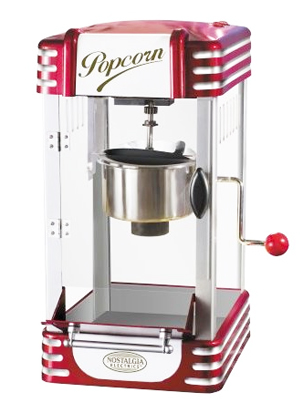
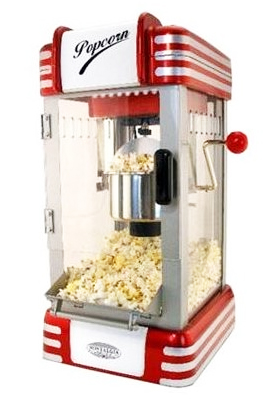
Note that these photos show two different models. The one to the left is what I saw in BB&B.
Marketed as Nostalgia Electronics' Retro Popcorn Popper from Helman Group products, this is also selling in Amazon and Target, priced at or about about $99. I considered buying one from our local BB&B, with one of their 20% off coupons. But as cool as this thing looks, I was able to notice from the one on display, that there is not enough space inside it to hold even the contents of a medium popcorn bag from the average moviehouse.
Then I began to read all the consumer reviews on Amazon for that product, where it's listed for sale from several sellers at different prices. The general consensus of all the reviews is that this is a very cute TOY that's not very well built, and does not work well. And the product description begins with an outright lie: They refer to it having a "large kettle."
Okay, let's stop and think for a minute. The simple, stove-top, manual stirring kettles, available from Target, BB&B, online, and elsewhere, are all six quarts. Electric models like Stir Crazy also hold six quarts, but they make a larger one (like mine, which just broke down) that produces up to eight quarts. A company in Canada Makes a stovetop model that's also eight quarts. So you can surmise that six quarts is standard, and eight is large. The kettle in the Helman Group Nostalgia Electronics Retro Popper is about the size of a cereal bowl, yet they call that large. And their product description refers to it making up to a gallon of popcorn per batch... which would not even fit in the popper itself. Combine this blatant misinformation with consumer reviews stating that the company's customer service was lacking, plus my own unsuccessful experience trying to contact them numerous times in several ways for this article, and you can only conclude that this is NOT the product to buy.
Further research turned up another popper, made under a familiar household name: Waring...

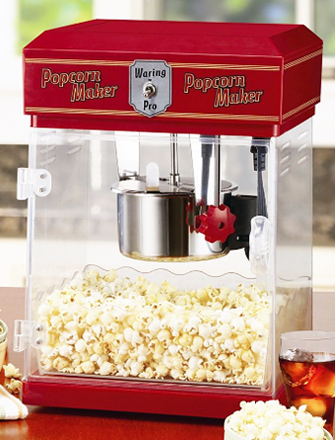
The Waring WPM25 looks like a very small version of a typical modern movie popper, and is not excessively decorated or oddly shaped, like some of the pro models I've considered for Home Theatre use. It is clearly made almost entirely of plastic, but there is a nice, useful touch: That wavy line is not just a decorative pattern on the housing...
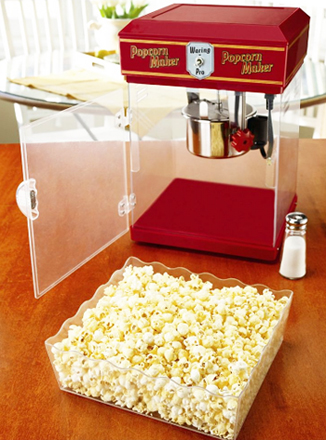
It's a handy removable tray, that would make cleanup a lot easier, however it's not made of clear plastic as you see here.
The Waring WPM25 is on sale at places like Macy's and Amazon, for the same price as the cute, toy popper above, which makes it a more practical choice for those considering that one. Waring refers to this as a "pro" model, but that is just a name...
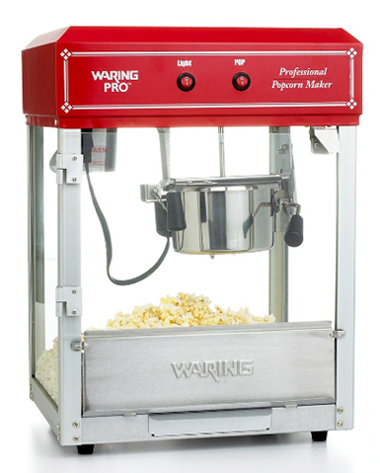
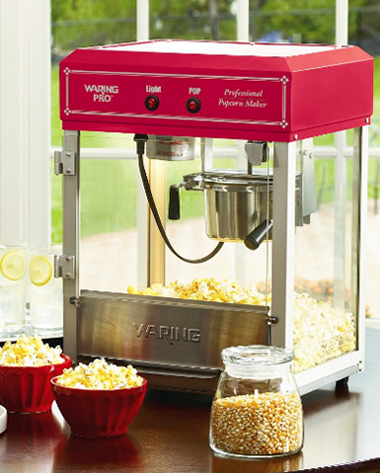
Waring's WPM40 appears, from the pictures, more like a professional grade. Constructed of metal and plexiglas, it has a door with a drawbridge-style lower panel that allows easy scoop access, a floor that is perforated in one spot to catch broken and unpopped kernels in a pull-out drawer. It appears to be just a smaller version of what we see in theatres. This model sells for $199.
The prices of the two Waring models are pretty much the same everywhere you look. Sometimes you get free shipping, (Amazon) sometimes you don't. There are very few reviews of these models, so I didn't have enough conclusive feedback. I was willing to give Waring enough benefit of the doubt to buy one for myself for Christmas... However, when I set out to research my purchase, the product detail available on these two Waring models ranged from conflicting to simply inaccurate. The two most important details we need to know before we decide on which model to buy, are how much popcorn does each model make at a time, and how big are they? If, like me, one has limited space, knowing the dimensions is crucial.
There was a good deal of frustration in trying to get product information. Amazon listed two different sizes for the WPM25 on the same page: 11 by 11-1/2 by 17" vs. 14.2 x 14.2 x 20.1" (maybe that's the size of the box??) and they listed a somewhat smaller size for the WPM40, which, based on the picture and price, didn't make much sense. There is also, throughout the internet, a lot of contradictory information on how much each model produces. Of all the various websites that feature these two items, the least information was furnished on Waring's own website. You get one picture and a model number on Waring's site, but that's pretty much it.
I sent Waring several e-mails, and made several phone calls. Their customer service was no help - it was hard enough to get someone on the phone, and explaining what I wanted to know... well, you know. They really don't know any more than I was able to find out on the net, if that much. I found a press release for the WPM40 online, and emailed the two people listed on it: a press rep, and a person from Waring. Neither answered the email. (I did get an "out-of-office" auto-response email from Waring) I called them both on the phone, got voicemail from the press rep, and was told at the number for Waring that the person From Waring named on the press release was terribly busy, and most likely would not even see/open my email. The person who answered the phone agreed to at least have someone contact me about the discrepancies in their specs.
About a day later I got an email from Conair, Waring's parent company, that stated: "Once the unit was in production we realized that we could increase the popping rate and thus the inconsistency for cups. We have since changed the packaging but some of the websites may not have the most updated information. WPM25 pops up to 8 cups, WPM40 pops up to 12 cups"
12 cups = 3 quarts, meaning that even the larger of the two models produces only HALF the output of a standard stovetop popper that sells for $20. Keep that in mind throughout this report.
Popping temperature is crucial to good popcorn, and seriously affects the apparent volume of popped corn. Too hot = smaller, chewy, ball-shaped kernels that lie closer together in a container, while medium hot = butterfly-shapes, fluffy and crispy, and that shape makes the kernels take up more space in a container. So to increase the popping rate, did they make the kettles bigger, raise the temperature, or just instruct the user to wait longer, until the kettle gets hotter? It is also necessary that any popper lid be vented to allow steam to escape, otherwise you get soggy, chewy popcorn.
And what about the size?? I sent another email out, and the answer was simply: "WPM40 L 15 1/2 W 12 1/2 H 21" Now, If you look at the pictures of the WPM40, you can see that really means 15 1/2" wide, 12 1/2" deep (front to back), and 21" high, which is a big difference from the 16x13x12.5" Amazon said. That still left us with the two conflicting sizes Amazon reported for the WPM25. I considered bringing a tape measure to a store. Macy's had advertised the WPM25 in a sale circular, but most of the stores I contacted didn't have one. The stores that did have one were too far away for me, so examining a display model was out for the time being.
So this left me like a old-movie cliffhanger with a lot of questions. Were either of the Waring poppers worthy of our Christmas money? Why, I wondered, should a paying customer have to fight so hard for the information necessary to spend one or two hundred bucks?? Did Waring give a hoot that recession depressed customers might want to know what they're buying before they shell out so many of their dear deflated dollars? If I bought one, would I get it before Christmas? Will it work at all? Is the niftyness factor worth the smaller output? (remembering my stovetop kettles produce 6qts and the Stir Crazy 8qts, or it did before it broke)
Meanwhile, the makers of other small to midsize theatre style poppers discounted even larger models to $30-60 less than Waring's WPM40, which is intriguing, but those models are not particularly attractive. I finished this article with those questions and posted it, sending a link to the two aforementioned people on the press release...
The next morning after this page went up, I received a very nice call from the lady in charge of PR for Waring. She was very apologetic, and clearly determined to erase my frustration, wanting to provide all the information I needed. So someone associated with Waring does indeed give at least a couple hoots about all this... I also spoke with her sharp assistant, who took down plenty of notes, and set out on a net search to see just how much misinformation about these products is out there. Now, you know these people probably have plenty of other matters to handle, but they both gave me the impression that this was on the top of their list.
I have been sent spec sheets for both Waring Models, and surprise! According to the spec sheets, which I'm told are the latest, neither model was actually the size being listed on Amazon or elsewhere. They say the WPM25 is 14.2x14.2x20.1" totaling 2.3 cubic feet at 13lbs., and the WPM40 is 19x16x23" totaling 4.05 cubic feet at 29 lbs.
I've been fumbling around my tiny kitchen with a tape measure, trying to figure out where my new theatre style popper will go. Had the dimensions published by Amazon been correct, it would have fit perfectly under a cupboard, in just the right corner, taking up counter space that's not needed for cooking or food prep. Now it seems the (WPM40) popper would either displace the blender, food processor and toaster, or live on the kitchen table, where I rarely sit, but one can't be sure until it arrives...
The way the Waring poppers were photographed, it looked like each had two different versions; the roof might either be flat, or extended upward with a slight inward bevel. I was told they all have the little beveled top, and that it just didn't show as clearly in the straight-on shots. I initially insisted that couldn't be, but after I examined the photos, I realized it's true. Even my own photo below makes you look twice before you realize it's a beveled top and not a flat top in perspective.
I have to point out that Waring 'Pro" is a marketing title for a line of Consumer products, while their products made for actual professional use are called Waring Commercial. In Fact, Waring Commercial makes another model, WPM60, that's bigger. The WPM40 is missing a feature that actual Professional poppers have: a heated deck (heating element in the base). The WPM40 and WPM60 use a downturned heat lamp to warm the popcorn. I'm not a genius on physics, (or much else!) but I do know that heat naturally travels UP, so a heated deck is preferable, and should have been included at this price..
Waring's press release on the WP40 also refers to a removable tray. This is a little misleading, as it sounds as if there is a serving tray like the WPM25 has, but what they're really referring to in this model, is the little drawer to catch the broken and unpopped kernels.
I managed to get to a store called Sur La Table, a high-end housewares store at the Grove/Farmer's Market in Los Angeles. Among all the neat stuff they stock is the WPM25. The store manager and staff were all very good sports, not only letting me take pictures, but also demonstrating the popper for me...
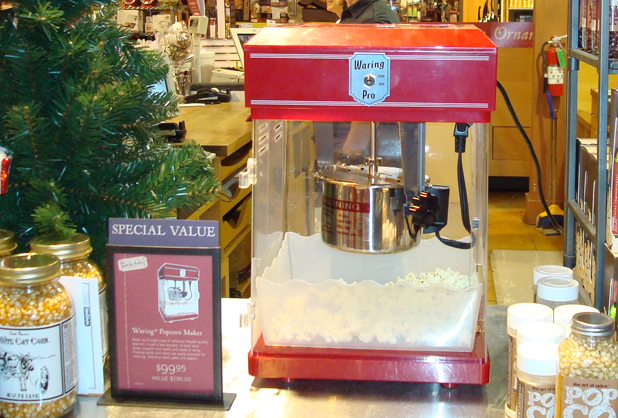
The door is removed in this picture, because while it is popping, steam clouds up the plastic. Note that this model, exclusive to Sur La Table stores, differs from the others by not having the words "Popcorn Maker" on both sides of the switch. (a plus in my opinion) The removable tray is not firm clear plastic as it appears in some product shots, but rather a thin, flexible, cloudy plastic.
The Kettle here is (like the Nostalgia Electronics model) about the size of a cereal bowl, but the WPM25 is still a better bet because it has more space for the popcorn to go. I took a little video footage of it working, which I'll post as soon as I figure out how, but the most telling thing about this visit was when the Sur La Table lady kindly loaned me their tape measure...
So, is the WPM25 the size in listed on Waring's latest spec sheet? No. Actually it's about 11.5 x 10.25x17" - I can also say that the word "Pro" is just a name here. It's very cute, and If you're a small family who like a little popcorn now and then, it'll do fine, but I'm glad I chose the WPM40, which seems a better choice for a Home Theatre setup where you might actually have some guests.
I was told to expect a call from Waring, but never heard a word from them. In a running dialogue with the head of Waring's PR firm, I was told that they were already communicating with Amazon about getting all the product info right. Their own spec sheets (which refer to "Master Pack" and "Unit Carton" dimensions) don't indicate the real size of the product itself, but Amazon now has what I'm told are the correct dimensions for both models.
Waring also has the WPM60, in their Waring Commercial line, which is supposed to be the real professional model, but it's just a bigger version of the WPM40, with no heating deck, at a price that would get you a better model from most other manufacturers.
When my WPM40 finally arrived, It took longer than expected to assemble because the parts supplied don't quite look like the parts illustrated in the book. I found right away that the "warming light" was a joke: a standard 60 watt bulb, shielded away from the inside of the popping well, does nothing more than glare directly into the eyes of your waiting "customers" or anyone else looking at the popper from the side or front of the unit. This warms nothing but the plexiglas closest to it, and to actually warm any popcorn, one would have to actually hold popcorn directly up to the bulb. You could bake a brownie in an Easy-Bake oven before you could warm a kernel of corn with that bulb. I replaced it with a small 40 watt appliance bulb so it could at least light the inside without as much glare.
So there is no hope of keeping popcorn warm in this unit whatsoever. What it should have is a heating element in the bottom like the REAL professional models. Remember this is a pro unit in name only. Even if one found a real heat lamp and put it in the WPM40, it would probably melt the plastic windows before it could warm any popcorn, because it's positioned in a corner that's shielded from the inside of the well, and this focuses more light to the side and front windows than on the popcorn.
When I actually tried to make popcorn with this unit, I quickly discovered that it does, as one previous review on Amazon noted, waste a lot of kernels. It took some experimenting to at least cut down the amount of unpopped kernels, and the result is nowhere near the volume Waring claims this unit makes per batch. The most you can hope to effectively pop per batch is about a quarter to a third of a cup of kernels, which nets just a small single serving of popcorn. (the smallest size you can get at the movies)
So you would really have to keep popping numerous batches to serve more than one or two people... and you would be busy, because the time inbetween batches being unloaded has to be spent raking the corn over the holes in the bottom of the unit to catch all the unpopped kernels... That "old maid" drawer will fill up with wasted kernels faster than the main section will fill with popped corn. It won't catch all the unpopped kernels, because a few will get stuck in the sides and corners of the floor. The floor does lift up, but this does not make cleanup easier, because all the stuff that's caught in the edges will just fall underneath, and you'll have to go hand picking the debris from the underside, where the heating element should be.
Waring's website sells replacement parts for the WPM40, and this detail is very telling: a replacement door costs $70 while a new kettle is only $40! Why is the kettle, the most important element, less expensive than a Small plexiglas door? If the door needed replacement, I would just take it to a big hardware store like OSH or Loews, have a new piece of plexiglas cut out, and just screw the existing hinges onto the new piece, all for a lot less than $70 (plus shipping and handling)
My experience investigating the two Waring models left me with the distinct impression that Waring as a company had little knowledge of the products or concern about my inquiries. Despite numerous promises from their PR company, no authority from Waring ever took the time to speak to me, or answer any of my questions directly. Perhaps because they had little actual knowledge of the products themselves, or because they knew the answers would not be good. When I was sent information, I replied back more than once that the info furnished didn't quite make sense, especially since even their published spec sheets had incorrect info on the size, etc.
I totally appreciate the PR firm for doing all they could to help, which included sending me the WPM40 and sparing me the expense of buying one. That turned out to be more helpful than they realized, because if I had actually paid $200 for one, I'd have been breathing fire for months!
Further research uncovered two models on Amazon called the Roosevelt and Lincoln that are slightly bigger, slightly more expensive, somewhat less attractive (I'm not a fan of their oddly shaped tops) and much more functional than the Waring models... Both units have a heated deck to warm the popcorn from below, and the more conventional arrangement of double doors (easier to swing out of the way than one big door). These units are just $70 more than the WPM40, and they are manufactured by a company that specializes in making real professional popcorn poppers. Haven't tried one yet myself, but If I were making a purchase, I would likely spend the extra bucks to buy one of those.
- TJ Edwards
Any purchase originating from a click here will earn a tiny commission for Cinema Sightlines.
Has anyone actually bought one of these poppers? Tell us your experiences!

